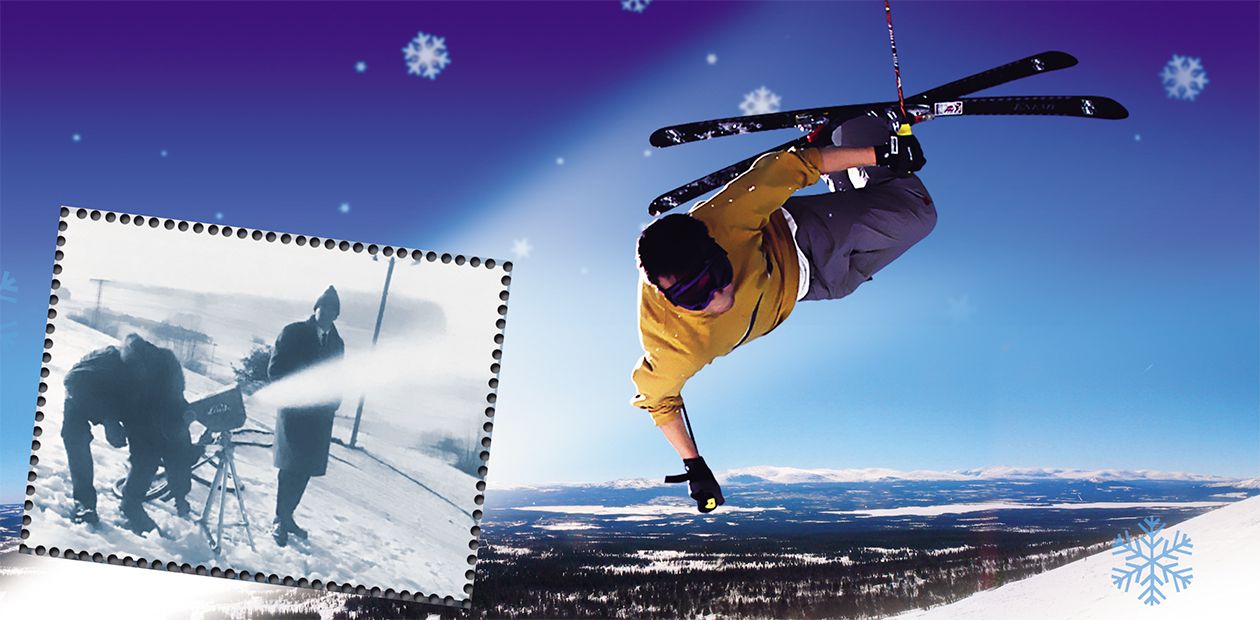How to Make Perfect Snow
Each snowflake seemed much larger than it really was… And how ideal they were! Not a single incorrect line! If only they did not melt! Hans Christian Andersen “The Snow Queen”
“To the North Pole with own snow?” This kind of natural first reaction can be expected from the readers recollecting Andersen’s immortal ‘Snow Queen’, especially when they find out that the authors are living and working in central Sweden, about 500 km north of Stockholm (the altitude corresponding to the point about 100 kilometers north of Anchorage, Alaska). And it almost inevitably will be followed by, “Is 1 m of snow not enough?” Actually, the answer is, “It depends…” If you are digging your car out in the cold morning after a heavy snowfall for a third time in a week, even 5 cm of snow, sure thing, is more than enough. But if you are waiting till mid-January to put on your beloved downhill gear and to get to the favorite slope, and then outdoor temperature drops below –25° С and stays like this till mid-April, after which the snow melts in a week, let’s see what you would say…
So, it should not be surprising that there is someone willing to pay for the thing falling from the Heavens ‘for free’. And, consequently, there are people who make the equipment for ‘manufacturing’ snow. When using proper snowmaking equipment, alpine ski resorts, including the ones in Siberia and central Sweden, extend the season up to four months (two in early winter and two in spring). And these are commonly the best four months for skiing, not too cold and not too warm — perfect for a family outing
Hundreds of names for snow
They say that in northern Scandinavia local people have up to a hundred words for “snow”. It is not surprising: in winter there is a lot of it around, and its structure is extremely variable depending on temperature, humidity and other factors. Those who are fond of skiing are well aware that snow can be “hard”, “soft”, “wet”, and so on and so forth. Some days you slide easily, another day you struggle to gain at least some speed even when going downhill.
With modern sports, a tenth of a second may decide the fate of skiing medals. With alpine skiing and downhill events, we already speak about a decisive hundredth and thousandth of a second. And then the event sport lovers have been waiting for years is suddenly cancelled when the tickets and hotels are already booked and paid for. All this happens because the Heavens did not send the desperately needed snow to the ‘proper place’, but it somehow managed to fall out by your garage doors — yet again.
According to the research carried out by the Swedish Regional Climate Modeling Program (SWECLIM), the annual mean temperature in Sweden is expected to rise by 3.8° C by 2100. Calculations suggest that the warming of the Nordic region will be more intense than the global average, which can bring a lot of disappointment to winter sports fans. Also, the increase in average precipitation will most probably be due to the increase in the summer and autumn rains. Together with the increase in the average winter temperatures it would lead to a lack of snow and to late openings of alpine skiing seasons both in Sweden and in Siberia. For example, the season in Eastern Siberian alpine ski resorts in the winter of 2003 was opened on New Year’s Eve, and in the winter of 1998—99 only on January 3d.
So in winter sports ‘artificial’ snow is associated with stability and quality. Snow generating equipment is used when we want to have a grip over the situation: there must be enough snow anytime we need it, it must be where we need it, and with the quality we can control. It is worth noting that the main applications of snowmaking equipment are not confined to skiing slopes and cross-country tracks. It is also used for testing aircraft de-icing systems and winter tires, and even in forestry: to protect young trees from frostbites by generating small snowdrifts around them.
Is it easy to make snow?
Most people are sure that snow is very easy to make: one only needs water and cold weather. Yes, it looks very simple, but appearances could be deceptive. So we suggest that those who live in a cold climate carry out a simple and safe experiment. Take a water-spray bottle (the one used for watering houseplant leaves or for ironing), fill it with cold tap water and get out on a cold (say, below —10° С) winter day. Now, start spraying the water high into the air. Do you think you will get snowflakes? No, what you will get is tiny shining spheres of ice.
But how does it happen that these nice fluffy things start floating in the air as soon as real winter begins? We can give you a small hint: it happens high in the skies, snowflakes are the result of slow nucleation of tiny crystals from the mist of the clouds. If the conditions are not right, something else will fall down from the sky: either the ice balls of the summer hale, or something looking more like semolina or puffed rice (“grainy”, granulated late autumn snow).
So, what is necessary to make snow? Obviously, water at certain temperature, dispersed in a certain way, cold air and… some magic or high-tech equipment — whatever we can lay our hands upon. Now we can say, ’Let it snow’, and let snowmaking begin.
A glance into the ‘snow gun’ barrel
These are some details for the inquisitive readers who are not afraid of certain technicalities. There are two major types of snowmaking machines used today: fan-assisted (commonly called ‘snow guns’) and high-pressure tower-based ones, or ‘lances’. In systems of the first type, tiny water droplets are injected into the continuous air flow generated by a high-power fan.
Water-air mixture jetted by the snow gun needs to spend some time floating in the cold air before it drops down as properly formed snow. Thus, it is very hard for a fan-type snow generator to put snow right on the ski track; good snow is formed somewhere from 10 to 20 meters away from the ‘barrel’ outlet. This can be achieved if we use ‘lances’, which are also cheaper than fan-based snow guns, though fan guns provide better performance.
All modern snow generators include some automation features, ranging from simple protection switches to complete automated control systems.
The art of snowmaking
A modern snowmaking system is more than just a few snow guns placed along a slope or a ski track. Obviously, it should also include water pipes and electric cables laid along the slope. Water pipes should not freeze over winter, so they are commonly laid into the ground (in Siberia and in central Sweden, at least 50—70 cm below the surface). At certain intervals, “connection stations” for the snow guns should be arranged, including electric and water connections (hydrants).
Do not forget that an average alpine or downhill skiing slope may be more than a kilometer long with a height difference of 400—500 m. So ten or more “connection stations” are needed, as well as a high-pressure (up to 40 Bar!) high-capacity water pump placed at the bottom of the slope. To generate enough snow (commonly, a 10—20 cm deep layer) for a one-kilometer slope, four to five air guns, each consuming up to 500 liters of water per minute (or an average bath tub in 15 seconds!), should be moved along the slope working non-stop for five to seven days. In general, a modern snow generator is capable of producing up to 100 m3 of snow per hour. Snow guns with hydraulic-assisted rotation may cover up to 1000 m2 of the surface each.
Snowmaking for cross-country skiing is not much easier. Though the height difference along the ski track is not that significant, the overall length of the tracks easily reaches dozens of kilometers. Laying such long water pipelines is expensive. So, one of the possible solutions is to mount the snow gun, pumps, and water tank on a car or a caterpillar chassis allowing the operator to move freely along the ski tracks. In this case covering large surface areas is just a question of time.
So, how can you see if the generated snow is of good quality? First of all, how can you measure this quality? Specialists say that perfect snow for downhill slopes should have a density of 400—500 kg/m3, or be about 2—2.5 times lighter than solid ice.
Plainly speaking, measuring density means weighing a ‘piece of the snow pie’ of certain size carefully cut out of the slope. Actually, there is an easier way. You can often see snow engineers wearing black winter jackets made of certain fabric. Surprisingly, it is not just a uniform, but a ‘snow quality control tool’. The snow engineer goes to a working gun and stretches his arm just into the flowing snow about 15 meters away from the gun ‘barrel’. After about 15—20 seconds (precise numbers are a secret of the trade) the arm is withdrawn, the engineer goes away from the flowing snow and shakes the hand trying to dust off whatever snow was stuck to the fabric. If everything falls away, the snow is too dry. If almost everything stays, the snow is too wet. Proper quality is somewhere “in between”. This is where the art of making snow really begins.
Recipes of good snowmaking
Modern snow generators can easily adjust to make proper snow at any sufficiently low temperatures. But what happens if the weather (temperature, humidity) is changing quickly? Surely, the conditions for snowmaking change and some adjustments should be made to maintain the high quality of snow. Fortunately, modern snow guns have a certain degree of automation, which spares the system supervisor the trouble of shuttling up and down the slope in order to make adjustments. The automatic control can be both at the level of a separate snow generator and at the level of the whole snowmaking system. Complex automation systems often include weather stations, microprocessors, and computers, and are capable of working without much interference for weeks and months.
In the “restauranteur” terms, the “art of snowmaking” with a good modern automated system looks like a few-sentence manual for a bread-making machine: “Take flour, yeast, add water, press the green button, wait till the bell rings — ‘presto’, it is ready to serve”. Of course, a good chef always works in an old-fashioned way: he’ll do everything by hand and will trust his eyes and nose. The same is true of a good snow-system supervisor (‘snow chef’) who with years and years of snowmaking experience can optimize the system taking into account the haze around the sun on the previous day, the color of the sunset, squeaking of the snow on the previous night, and Lord knows what else… But one must realize that a good chef, same as a good snowmaking supervisor, is hard to find and their salaries are astronomical. So, all in all, computerized systems are cheaper, easier to maintain, and they will never argue if they have to work overtime.
One can expect that snow slopes for alpine and downhill skiing events where “crme de la crme” compete are prepared manually by the “snow chef”. However, modern sporting events need certain standardization of the equipment and conditions; all competitors deserve to get “equal treatment”. Even in places with abundant natural snowfall the organizers of skiing competitions more and more often turn to automated snowmaking systems, because otherwise it may be extremely hard to achieve standard snow conditions.
Photographs used in the paper are the courtesy of A. Koptyug and ARECO Snowsystem













